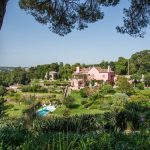Tread lightly in the footsteps of monks….
The Xintara retreats are located at Quinta Sao Bento, an original 16th Century Portuguese Quinta in Sintra, Portugal.
For many hundreds of years, monks came here to recharge their batteries and now in the modern age you too can have a similar experience although in somewhat more comfort and splendour.
We only know about the history of the property, as a letter was found asking permission by the first owner to build his own chapel, as the roads leading to the nearest village church were often closed by rain. The history of the property starts with Gaspar de Cisneros, a noble Knight of the House of the Duke of Braganza. Gaspar described his property as a ‘noble and sumptuous Quinta’ and following his request to build a chapel (capela), was granted permission in 1548 by the church authorities.
In 1551 Gaspar gifted the Capela and surrounding land to the Monastery of the Trinity, which maintained the Capela into the 18th Century. The Quinta became used as a place where monks that had fallen ill could come and convalesce before returning to their monastery further up the Serra.
The garden terraces cut into the hillside and the available spring water would have provided an ideal opportunity to grow vegetables and fruit. The Portuguese Quinta was as much regarded as a small agricultural estate or farm than as a grand or sophisticated manor building.
The Quinta’s chapel The Capela (Chapel) of Sao Bento is considered to be a very good example of Portuguese Renaissance architecture. As described in the Guide of Portugal of 1924, the interior walls and ceiling were covered in fine frescoes, representing the Annunciation and other religious scenes. Due to lack of maintenance over the years, all that remains today are the frescoes on the ceiling, which include the allegoric figures of the four Cardinal Virtues. The stonework is of particular fine quality and it is thought to be the work of Nicholas de Chanterenne, a highly considered French sculptor, who was employed during that period by the Portuguese King Dom Joao III.
It is rumoured that the Capela was built on the foundations of a Knights Templar chapel dating back to the 12th Century and that prior to this, the site had been occupied by a Roman temple. This is supported by some limited excavations carried out in the 1920s by a house guest of the then owner, the Countess of Carrick
In 1755 Portugal was devastated by an earthquake. The Marquis of Pombal, the illustrious Prime Minister responsible for rebuilding much of Lisbon, sought to reduce the power of the Catholic church and seized Church lands across the country. It is not known when the State took over the Quintas but by 1867 Admiral Sartorius, a distinguished naval officer bought the properties and gave his daughter, Dona Isabel the opportunity to live in Sao Bento with her husband Major Astley Campbell Smith, the illegitimate son of William IV.
In the 1920s the Irish Countess of Carrick purchased the Quinta and lived here until her death in the 1940s.The Countess was buried in the local Sintra cemetery but her memorial stone carved with the Celtic cross, lies directly in front of the Capela, overlooking the valley. Her daughter, Lady Hobson inherited the property and in the 1950s had the Capela consecrated by the Bishop of Gibraltar.
In 1981, Peter and Monique Bryers purchased the property and undertook an extensive restoration of both the Quinta and the Capela and the Bryers family continue to manage the property today.
Recharging and convalescence from modern living are increasingly recognized as important ways of sustaining us. It does not need to be complicated- good healthy food, the beauty of a garden and forest, some physical exercise and mental training (as per today’s practice of yoga and meditation), and quiet seclusion are all that are required. It is clearly not a modern invention… but something recognized over many centuries and experienced by the previous monks who stayed here at Quinta Sao Bento over four hundred years ago.




